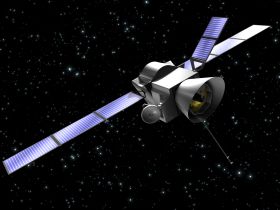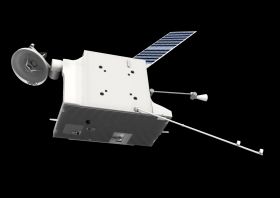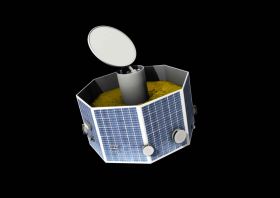|
|
|
 |
 BepiColombo
BepiColombo
|
|
|
BepiColombo
 The BepiColombo Mission to planet Mercury is a joint project between the European Space Agency ESA and the Japanese counterpart JAXA to be launched in 2013 and orbiting Mercury from 2018 onwards. The project named after
The BepiColombo Mission to planet Mercury is a joint project between the European Space Agency ESA and the Japanese counterpart JAXA to be launched in 2013 and orbiting Mercury from 2018 onwards. The project named after  Guiseppe (Bepi) Colombo consists of two spacecraft: Guiseppe (Bepi) Colombo consists of two spacecraft:
- the Mercury Planetary Orbiter (MPO) provided by ESA and
- the Mercury Magnetospheric Orbiter (MMO) provided by JAXA
providing for the first time two-point measurements in the vicinity of the closest planet in our solar system.

|

|
MPO
Total mass: 400 kg
Payload mass: 50 kg
|
MMO
Total mass: 220 kg
Payload mass: 41 kg
|
Science objectives (from ESA website)
- Origin and evolution of a planet close to the parent star
- Mercury as a planet: form, interior, structure, geology, composition and craters
- Mercury's vestigial atmosphere (exosphere): composition and dynamics
- Mercury's magnetized envelope (magnetosphere): structure and dynamics
- Origin of Mercury's magnetic field
- Test of Einstein's theory of general relativity
The scientific objectives behind BepiColombo can be viewed by considering the following 12 questions:
- What can we learn from Mercury about the composition of the solar nebula and the formation of the planetary system?
- Why is Mercury's normalized density markedly higher than that of all other terrestrial planets, Moon included?
- Is the core of Mercury liquid or solid?
- Is Mercury tectonically active today?
- Why such a small planet does possess an intrinsic magnetic field, while Venus, Mars and the Moon do not have any?
- Why do spectroscopic observations not reveal the presence of any iron, while this element is supposedly the major constituent of Mercury?
- Do the permanently shadowed craters of the polar regions contain sulphur or water ice?
- Is the unseen hemisphere of Mercury markedly different from that imaged by Mariner 10?
- What are the production mechanisms of the exosphere?
- In the absence of any ionosphere, how does the magnetic field interact with the solar wind?
- Is Mercury's magnetised environment characterised by features reminiscent of the aurorae, radiation belts and magnetospheric substorms observed at Earth?
- Since the advance of Mercury's perihelion was explained in terms of space-time curvature, can we take advantage of the proximity of the Sun to test general relativity with improved accuracy?
Mission Facts
| Launch Date |
Aug-2013 |
| Mission End |
Nominally 1 year in Mercury orbit until September 2020 |
| Launch Vehicle |
Soyuz 2-1B/Fregat-M |
| Launch Mass |
2300 kg |
| Cruise |
Heliocentric transfer orbit |
| At Mercury |
MPO polar orbit 400 × 1500 km, 2.3 hr period
MMO polar orbit 400 × 12 000 km, 9.2 hr period |
The Journey
The trajectories of the MPO and the MMO are shown below compared to the orbit of the NASA Messenger spacecraft.
Scientific Payload
MPO:
| BELA - BepiColombo Laser Altimeter |
| N.Thomas |
Physikalisches Institut University of Bern, Switzerland |
Co-PI |
| T. Spohn |
DLR Inst. für Planetenforschung, Berlin, Germany |
Co-PI |
| ISA - Italian Spring Accelerometer |
| V. Iafolla |
CNR-IFSI, Rome, Italy |
PI |
| MERMAG - Mercury Magnetometer |
| K.H. Glassmeier |
Institute of Geophysics and Extraterrestrial Physics, Technical University of Braunschweig, Germany |
PI |
| C.M. Carr |
The Blackett Laboratory, Imperial College London, UK |
Deputy PI |
| MERTIS-TIS - Mercury Thermal Infrared Spectrometer |
| E.K. Jessberger |
Institut für Planetologie, University Münster, Germany |
PI |
| MGNS - Mercury Gamma ray and Neutron Spectrometer |
| I. Mitrofanov |
Institute for Space Research, Moscow, Russia |
PI |
| MIXS - Mercury Imaging X-ray Spectrometer |
| G. Fraser |
Space Research Centre, University of Leicester, UK |
PI |
| K. Muinonen |
Observatory Univ. of Helsinki, Finland |
Co-PI |
| MORE - Mercury Orbiter Radio science Experiment |
| L. Iess |
University of Rome "La Sapienza", Italy |
PI |
| Sami Asmar |
Jet Propulsion Laboratory, Pasadena, USA |
Co-PI |
| PHEBUS - Probing of Hermean Exosphere by Ultraviolet Spectroscopy |
| E. Chassefière |
SA/IPSL, Université P&M Curie Paris, France |
PI |
| S. Okano |
Planetary Plasma & Atmospheric Research Center, Tohoku University, Sendai, Japan |
Co-PI |
| O. Korablev |
IKI, Moscow, Russia |
Co-PI |
| SERENA - Search for Exosphere Refilling and Emitted Neutral Abundances (Neutral and ionised particle analyser) |
| S. Orsini |
CNR-IFSI, Rome, Italy |
PI |
| S. A. Livi |
Southwest Research Institute, San Antonio, USA |
Co-PI |
| S. Barabash |
Swedish Inst. of Space Physics (IRF), Kiruna, Sweden |
Co-PI |
| K. Torkar |
Space Research Institute, Austrian Academy of Sciences, Graz, Austria |
Co-PI |
| SIMBIO-SYS - Spectrometers and Imagers for MPO BepiColombo Integrated Observatory System (High resolution and stereo cameras, Visual and NIR spectrometer) |
| E. Flamini |
Italian Space Agency, Rome, Italy |
PI |
| F. Capaccioni |
INAF-IASF, Rome, Italy |
Co-PI |
| L. Colangeli |
INAF-Osserv. Astronomico di Capodimonte, Napoli, Italy |
Co-PI |
| G. Cremonese |
INAF-Osserv. Astronomico di Padova, Italy |
Co-PI |
| A. Doressoundiram |
LESIA-Obs. de Paris, Meudon, France |
Co-PI |
| O. Forni |
Institut d'Astrophysique Spatiale (IAS), Orsay, France |
Co-PI |
| J. L. Josset |
SPACE-X, Space Exploration, Neuchâtel, Switzerland |
Co-PI |
| SIXS - Solar Intensity X-ray Spectrometer |
| J. Huovelin |
Observatory University of Helsinki, Finland |
PI |
| M. Grande |
Space Science & Technol. Dept. CCLR-Rutherford Appleton Lab. Chilton, UK |
Co-PI |
MMO:
| MERMAG-M/MGF - Mercury Magnetometer |
| W. Baumjohann |
PI |
| A. Matsuoka |
Co-PI |
| MPPE - Mercury Plasma Particle Experiment |
| Y. Saito |
PI |
J.-A. Sauvaud
M. Hirahara
S. Barabash
|
Co-PIs |
| PWI - Plasma Wave Instrument |
| H. Matsumoto |
PI |
J.-L. Bougeret
L. Blomberg
H. Kojima
S. Yagitani
|
Co-PIs |
| MSASI - Mercury Sodium Atmospheric Spectral Imager |
| I. Yoshikawa |
PI |
| O. Korablev |
Co-PI |
| MDM - Mercury Dust Monitor |
| K. Nogami |
PI |
| H. Ohashi |
Co-PI |
MPS contribution
MPS is involved in 4 different Instruments and will provide hardware for them. On the planetary orbiter MPS is responsible for components of the Laseraltimeter BELA, the particle package SERENA, and the x-ray spectrometer MIXS. On the magnetospheric orbiter the institute is involved in the particle package MPPE.
Related links
|
|
|
|
|
 |
|
|
|
|
|
|
